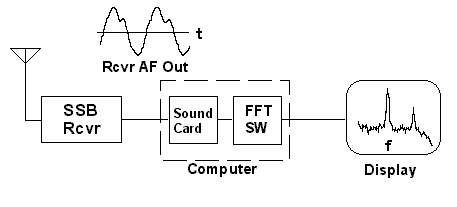In most cases the audio output of a good radio receiver in SSB or CW mode (it won't work in AM or FM mode) fairly represents the radio frequency spectrum near the tuned frequency of the receiver, and a software-based audio spectrum analyser can be used to study the radio frequency spectrum by looking instead at the receiver's audio output. In this way, the SSB receiver is used as a linear down-converter, converting the spectrum from radio frequencies to audio frequencies and saving a great deal of work (and expense!) for the spectrum analyser.
The receiver audio is fed to the computer's sound card which digitizes the audio signals, creating a continuous stream of amplitude measurements which represent the total audio waveform. This stream of measurements (which is referred to as being in the time domain) is then processed by the spectrum analyser program which transforms the measurements into corresponding amplitude values at different increments in frequency (now in the frequency domain). This transformation is done mathematically by using an algorithm for the Fast Fourier Transform, a technique that is both complicated and beautifully simple. The necessary calculations are not at all difficult but do require many repeated arithmetic operations, hence the need for a fast processor in the computer. So our time-series of amplitude measurements is transformed into an equivalent frequency spectrum of the waveform at the receiver's audio output, which represents the radio frequency spectrum near the tuned frequency of the receiver.
 There are, however, certain limitations in the FFT process, involving compromises between the number of samples per second taken by the sound card, the number of digital bits in each sample, the highest frequency present in the receiver's audio output, the number of measurements ("points") used each time the transform is calculated, the speed at which transforms can be calculated by the processor, the frequency resolution of the resulting transform, and so on. As you use a spectrum analyser you will become familiar with these compromises and trade-offs. With a sufficiently fast processor, the FFT can be done in real-time, so that we will have a continuous and reasonably accurate picture of the frequency spectrum of any radio signal within the receiver's bandpass.
There are, however, certain limitations in the FFT process, involving compromises between the number of samples per second taken by the sound card, the number of digital bits in each sample, the highest frequency present in the receiver's audio output, the number of measurements ("points") used each time the transform is calculated, the speed at which transforms can be calculated by the processor, the frequency resolution of the resulting transform, and so on. As you use a spectrum analyser you will become familiar with these compromises and trade-offs. With a sufficiently fast processor, the FFT can be done in real-time, so that we will have a continuous and reasonably accurate picture of the frequency spectrum of any radio signal within the receiver's bandpass. That, in a nutshell, is what a software-based spectrum analyser does.
Visit the next page for links to some spectrum analyser software that I believe is suitable for work with the Monitoring System.